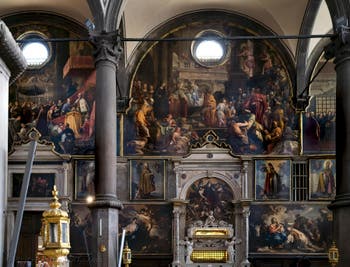Churches Saint-Mark | Miracoli | Stefano | Zaccaria | Murano | Chorus | Mass Hours
San Zaccaria Gothic and Renaissance | Golden Chapel | Opening Hours
San Zaccaria, St. Zechariah's church in Venice
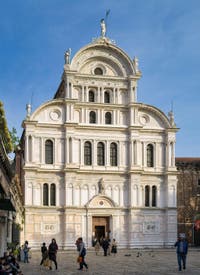
San Zaccaria Church It was founded in 827 by Doge Giustiniano Partecipazio and by the Byzantine Emperor Leo V, said the Armenian, who would have financed most of the building by sending money, artisans and artists from Constantinople.
The affiliated convent for noble ladies was mainly financially supported by the most prominent families in Venice and protected by the Doge.
Initially, the church and convent of San Zaccaria had been designed to receive the remains of St. Zechariah that had been offered to pledge friendship to Venice by the Byzantine Emperor Leo V.
To understand the strong links that existed at that time between Venice and the Empire of Byzantium, it is worth reading the proclamation of Doge Giustiniano Partecipazio about the founding of San Zaccaria:
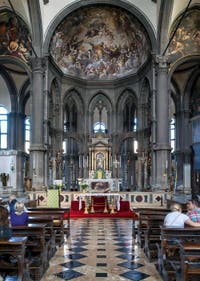
Interior of San Zaccaria
“May it be known to all Christians and faithful of the Holy Roman Empire, present and to come, to all doges, patriarchs, bishops, and other main characters, that we, Giustiniano, Hypate of the empire and Doge of Venice, by the revelation of Our Lord the Almighty God.
And by the serene Emperor Leo's command, conservator of the peace in all the world, after receiving many benefits from him, we had this monastery of virgins erected in Venice, following the will he had manifested, so that this building would be built at the expense of the imperial chamber.
As a result of this commission, he ordered that the gold and silver be given to us with the other necessary things.
He also sent us, to consecrate this church, relics of the prophet St. Zechariah, a piece of wood of the cross of Our Lord, a part of the robe of Saint Mary or that of the Saviour, along with other holy relics.
Interior of San Zaccaria Finally, not only did he give all the necessary items for this construction, but he sent the masters to direct it and complete it promptly.
When the construction was finished, the congregation ordered continual prayers for the salvation of the holy Emperor and his heir.
We decreed that all the letters he wrote to us in gold characters would be definitively in our Palace's treasury, so we could never ignore that the monastery of St. Zechariah was built at the expense of the holy Emperor Leo.”
Giustiniano Partecipazio
Unfortunately, nothing remains of this initial construction and the original artists' works because of the many reconstructions and restorations that the church and the convent will undergo.
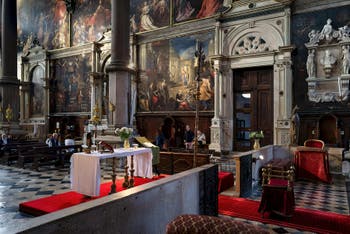
Interior of San Zaccaria The convent was rebuilt in 1105 after a terrible fire that caused more than a hundred victims among the nuns who had taken refuge in the Crypt, where eight of the first Doges of Venice still rest today.
It was then rebuilt in 1456 by recycling stone from the island of Torcello, abandoned by its inhabitants.
Every year the Doge came in a grand procession to San Zaccaria to attend the Easter Vespers and thank the convent for granting part of his garden to enlarge St. Mark's Square at the end of the twelfth century.
Therefore the church of San Zaccaria had an exceptional status in Venice because of these ducal visits.
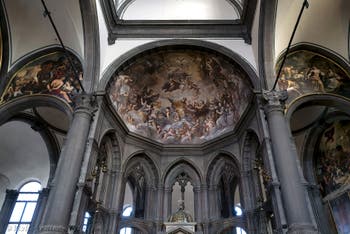
Girolamo Pellegrini St. Zechariah in Glory Abbess Morosini had offered Doge Pietro Tardonico (murdered in 864 on the square of San Zaccaria) a ducal cap made of gold and precious stones.
This hat became the headdress that all the Doges then wore when they were elected.
Today, you can visit the church of San Zaccaria but not its convent.
San Zaccaria under the sign of Music and visited by Mozart
Like many churches in Venice, San Zaccaria has participated in the musical tradition of the city.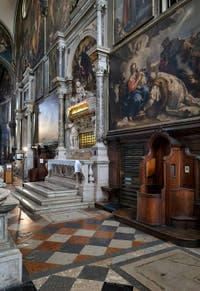
Interior of San Zaccaria In 1607, a French traveller listened to the song of the nuns, which he described as “A false bumblebee (a kind of accompaniment with parallel voices), moreover, very pleasant and composed of truly angelic voices.”
The nuns of San Zaccaria, all from noble families, also had a social life.
In 1771, the Mozart family, who was then passing in Venice, was invited for dinner by Sister Angiola Maria Priuli in San Zaccaria.
If you visit the church of San Zaccaria, you should not miss the Callido Organ, which dates back to 1790. This organ has a keyboard and 12 registers.
Until 1916 it was positioned on a large stand, hung on the wall of the entrance.
It is now placed behind the great altar: it is, therefore, possible to observe its keyboard, registers and pedals.
It is the only Venetian organ of the 18th century that is accessible to tourists.
San Zaccaria is a Subtle Marriage of Gothic and Renaissance

Interior of San Zaccaria The facade has a certain unity: the lower part is built of marble by Antonio Gambello in a late Gothic style announcing the beginning of the Renaissance, and the rest is in Istrian stone, in the Renaissance style by Mauro Codussi (or Coducci), from Bergamo.
The portal was created in 1483 by Giovanni Buora.
Antonio Gambello getting responsible for the reconstruction of San Zaccaria in 1458.
Antonio Gambello had already rebuilt the apse in flowered Gothic style before being entrusted with the church's reconstruction in 1458.
Girolamo Pellegrini (1624 - 1700) « St. Zechariah in Glory, San Zaccaria in Gloria »
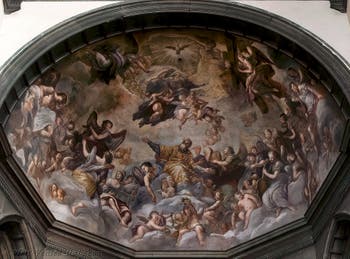
Girolamo Pellegrini St. Zechariah in Glory Basin of the apse of the church of San Zaccaria in Venice, Fresco, 17th century
In 1458, Gambello submitted a wooden model of his church project for approval by the convent of San Zaccaria.
The Venetian monastic tradition inspires the three naves of the church.
The church also consists of an ambulatory that follows the perimeter of the choir, bypassing four semicircular chapels, which does not exist in any other Venetian church!
Still, when Antonio Gambello drew the choir of San Zaccaria, he was probably inspired by the typically French church of Cluny.
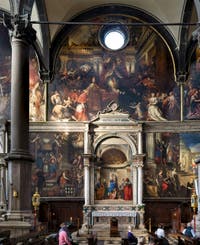
Bellini Madonna Another originality: the juxtaposition near the choir, the two arcades, one in Gothic style and the other in Renaissance style, with an aesthetic effect yet very successful!
Since the construction would last several years, Antonio Gambello was appointed “proto”, meaning “permanent project manager”, to carry out his work well.
Before dying (1481), Gambello had time to finish most of the eastern end and the slender columns, whose pedestals and capitals were carved by Giovanni Buora.
He would also have reworked the drawing of the lower and upper orders of the facade.
Mauro Coducci takes over from Gambello
When Antonio Gambello died in 1481, the church of San Zaccaria was already half-built.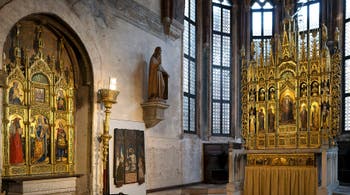
Golden Chapel Mauro Coducci, supported by the humanists Pietro Donà and Lorenzo Loredan, was commissioned to continue the work.
He has indeed succeeded in marrying Gothic and Renaissance styles.
That time was a transition era between the two styles.
The plan and the structure of the church of San Zaccaria are indeed by Antonio Gambello.
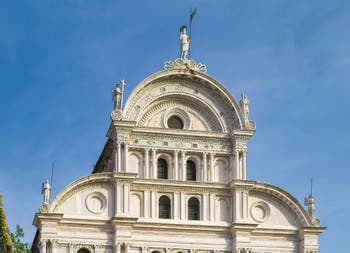
San Zaccaria Church Still, Mauro Coducci has managed to sublimate the spaces and embellish the facade by using superimposed colonnades.
The facade of the church is topped by a semicircular lunette that gives it originality and certain sobriety.
Mauro Codussi was born in Lenna, near Bergamo in 1440.
He had settled in Venice in 1469.
He completed this second phase of construction from 1483 to 1491.
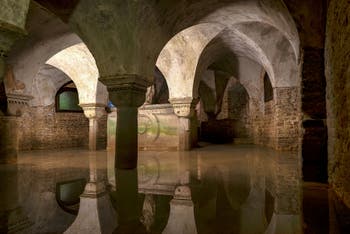
Crypt under the Golden Chapel The church of San Zaccaria was consecrated in 1543.
A rather complex set, made of added “pieces” and rebuilt over the centuries, constitutes the church in its current version.
This set shows a quasi-duplication of one church into the other, as you can see on the plan.
Despite these constructions and reconstructions, San Zaccaria is nevertheless one of the most beautiful churches in Venice.
San Zaccaria the Virgin and Child, Holy Conversation with the Musician Angel by Giovanni Bellini
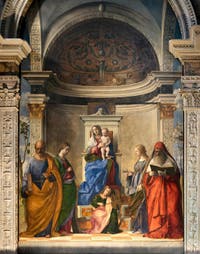
Bellini Madonna Painting - Oil on Canvas transposed on wood (500 x 235 cm) 1505
An angel with a childish face plays rape at the feet of the Virgin and the Child Jesus.
Together they make up the centre of the painting, surrounded by four Saints arranged symmetrically two by two:
On the left, St. Peter and St. Catherine.
On the right, St. Lucy and St. Jerome.
St. Catherine holds the palm of martyrdom; St. Lucy holds a cup where her eyes are located, reminding her of torment.
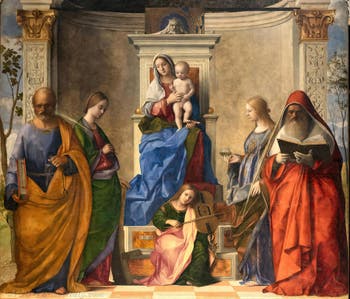
Bellini Madonna With his open book, St. Jerome is the doctor of the church who made green the dried tree (behind him) of the scriptures of the ancient tradition.
With his key and the book closed behind him, St. Peter figures Christ the giver of Grace who is beyond knowledge, and the ivy rod represents the strength of rooting in truth and faith.
In the dome at the top of the painting, you can see a Byzantine-designed Venetian lamp, preceded by an ostrich egg symbolizing Mary's virginity.
Finally, at the top of the throne on which the Virgin sits is the head of King David, to recall that Mary is part of his lineage.
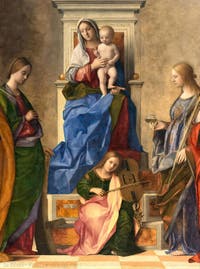
Bellini Madonna Many writers and artists have described this beautiful painting.
Dürer, who saw Bellini's work shortly after its implementation, declared to one of his friends that Giovanni Bellini, although already 75 years old at that time, surpassed in vitality all other Venetian painters. Henry James, in his book “Italian Hours” (1909), gave his opinion :
“The Madonna of San Zaccaria hung in a cold, dark, sad and also too high place.
But she is so gentle and serene, presented so marvellously that the only attitude possible for the most critical art lover, when looking at her, is to kneel in front of her.”
Henry James
Two Doges have been murdered near San Zaccaria!
On December 13, 864, the day before the celebration of the Exaltation of the Holy Cross, doge Pietro Tradonico, the "very glorious" Peter, was leaving the church of San Zaccaria after Vespers.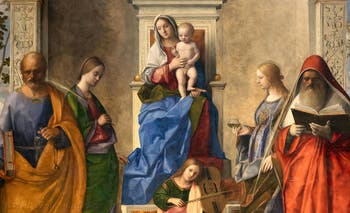
Bellini Madonna At this moment, he was reportedly murdered by some nobles who surrounded him without guards could protect him.
The fight between the aggressors and the Doge's guards was so violent that the Convent of San Zaccaria nuns could not recover the Doge's body until dark.
In mid-May 1172, Doge Vitale II Michiel was about to die near San Zaccaria.
Vitale II Michiel had tried to place his sons and nephews in crucial positions and had missed his expedition to Byzantium (although his councillors had preferred negotiation); so, he had to face the wrath of the Popular Assembly.
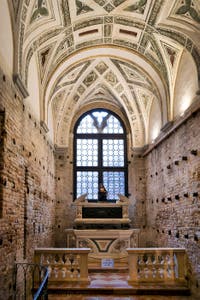
Interior of San Zaccaria Not only was his expedition a disaster, but he was also accused of having brought the plague with him on his boats.
This epidemic had already decimated thousands of Venetians.
At the same time, the crowd gathered around the Palace became more and more threatening and demanded his death.
He was threatened both by his peers' assembly, on the one hand, and by the people on the other; he only took flight as a solution.
So, he left the Doges'Palace through a secondary door on the side of the basin of St. Mark and ran along the Riva Degli Schiavoni to seek refuge in the church of San Zaccaria.
But he never reached the church and was murdered at the Sotoportego of San Zaccaria.
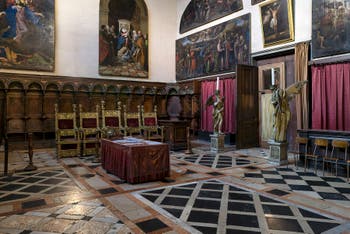
Stalls of chapel of Sant'Atanasio Some indicate that he was stabbed at the corner of Calle delle Rasse, while others claim that he was killed through the Sotoportego of San Zaccaria, pierced by an unknown who was waiting for him.
The “Sotoportego” version seems the most likely since the construction of the Canonica bridge was decided due to Vitale II Michiel's assassination.
So, his successors could go to increased security conditions, on Easter day, to the church of San Zaccaria, without having to go through the dangerous “narrows” of the Sotoportego.
San Zaccaria Gothic and Renaissance | Golden Chapel | Opening Hours
Churches Saint-Mark | Miracoli | Stefano | Zaccaria | Murano | Chorus | Mass Hours
Back to Top of Page


